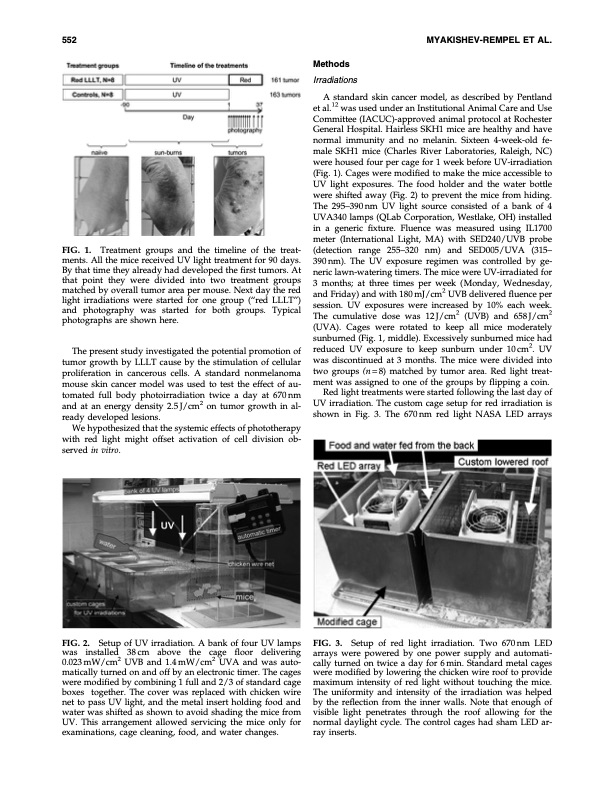
PDF Publication Title:
Text from PDF Page: 002
552 MYAKISHEV-REMPEL ET AL. FIG. 1. Treatment groups and the timeline of the treat- ments. All the mice received UV light treatment for 90 days. By that time they already had developed the first tumors. At that point they were divided into two treatment groups matched by overall tumor area per mouse. Next day the red light irradiations were started for one group (‘‘red LLLT’’) and photography was started for both groups. Typical photographs are shown here. The present study investigated the potential promotion of tumor growth by LLLT cause by the stimulation of cellular proliferation in cancerous cells. A standard nonmelanoma mouse skin cancer model was used to test the effect of au- tomated full body photoirradiation twice a day at 670nm and at an energy density 2.5 J/cm2 on tumor growth in al- ready developed lesions. We hypothesized that the systemic effects of phototherapy with red light might offset activation of cell division ob- served in vitro. FIG. 2. Setup of UV irradiation. A bank of four UV lamps was installed 38cm above the cage floor delivering 0.023 mW/cm2 UVB and 1.4 mW/cm2 UVA and was auto- matically turned on and off by an electronic timer. The cages were modified by combining 1 full and 2/3 of standard cage boxes together. The cover was replaced with chicken wire net to pass UV light, and the metal insert holding food and water was shifted as shown to avoid shading the mice from UV. This arrangement allowed servicing the mice only for examinations, cage cleaning, food, and water changes. Methods Irradiations A standard skin cancer model, as described by Pentland et al.12 was used under an Institutional Animal Care and Use Committee (IACUC)-approved animal protocol at Rochester General Hospital. Hairless SKH1 mice are healthy and have normal immunity and no melanin. Sixteen 4-week-old fe- male SKH1 mice (Charles River Laboratories, Raleigh, NC) were housed four per cage for 1 week before UV-irradiation (Fig. 1). Cages were modified to make the mice accessible to UV light exposures. The food holder and the water bottle were shifted away (Fig. 2) to prevent the mice from hiding. The 295–390nm UV light source consisted of a bank of 4 UVA340 lamps (QLab Corporation, Westlake, OH) installed in a generic fixture. Fluence was measured using IL1700 meter (International Light, MA) with SED240/UVB probe (detection range 255–320 nm) and SED005/UVA (315– 390nm). The UV exposure regimen was controlled by ge- neric lawn-watering timers. The mice were UV-irradiated for 3 months; at three times per week (Monday, Wednesday, and Friday) and with 180 mJ/cm2 UVB delivered fluence per session. UV exposures were increased by 10% each week. The cumulative dose was 12J/cm2 (UVB) and 658J/cm2 (UVA). Cages were rotated to keep all mice moderately sunburned (Fig. 1, middle). Excessively sunburned mice had reduced UV exposure to keep sunburn under 10cm2. UV was discontinued at 3 months. The mice were divided into two groups (n=8) matched by tumor area. Red light treat- ment was assigned to one of the groups by flipping a coin. Red light treatments were started following the last day of UV irradiation. The custom cage setup for red irradiation is shown in Fig. 3. The 670nm red light NASA LED arrays FIG. 3. Setup of red light irradiation. Two 670nm LED arrays were powered by one power supply and automati- cally turned on twice a day for 6 min. Standard metal cages were modified by lowering the chicken wire roof to provide maximum intensity of red light without touching the mice. The uniformity and intensity of the irradiation was helped by the reflection from the inner walls. Note that enough of visible light penetrates through the roof allowing for the normal daylight cycle. The control cages had sham LED ar- ray inserts.PDF Image | Preliminary Study of the Safety of Red Light Phototherapy Cancer

PDF Search Title:
Preliminary Study of the Safety of Red Light Phototherapy CancerOriginal File Name Searched:
phototherapy-for-cancer.pdfDIY PDF Search: Google It | Yahoo | Bing
Cruise Ship Reviews | Luxury Resort | Jet | Yacht | and Travel Tech More Info
Cruising Review Topics and Articles More Info
Software based on Filemaker for the travel industry More Info
The Burgenstock Resort: Reviews on CruisingReview website... More Info
Resort Reviews: World Class resorts... More Info
The Riffelalp Resort: Reviews on CruisingReview website... More Info
| CONTACT TEL: 608-238-6001 Email: greg@cruisingreview.com | RSS | AMP |